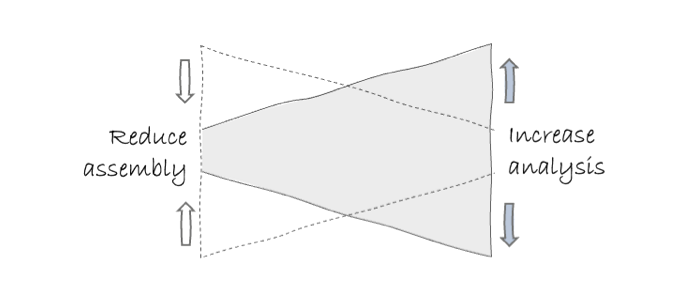While there have been great advancements in data capture and analysis technology, there still remains a propensity for individuals and business divisions / departments to feel the need to control their data from its very source and to be responsible for how it is prepared for analysis and how it is analysed.
A relevant case study is a story of an actuarial department within an insurance company. The department had grown from 6 to 8 to 10 professional actuaries in recent years but the volume of work and general performance of the department had not changed materially. The General Manager of the department decided to understand why.
Over a one-month period, an activity assessment was conducted across the department. Each actuary would note the time they spent on a category of tasks each day. The results revealed that over 70% of their time was sourcing, organisation and preparing data from many different internal and external areas to enable them to complete the analysis they believed they had time to do. Based on the activity assessment, analysis catered for around 30% of their time.
What was more interesting and concerning was that each of the individual actuaries did this assembly work for their own purposes and their approach to assembly and their interpretation of how to prepare the data varied dramatically across the team. In addition to this, the security of the data and the different approaches to storing the information were very different and, in some situations, compromising the organisations privacy and security policies.
The General Manager concluded that he wanted to shift the ratio of assembly to analysis from 70/30 to 30/70 and wanted all the actuaries to agree to a set of data definitions for key data.

Some months later a project was completed to create a central actuarial data environment that all of the actuaries accessed. After a period of time working in this new environment the same activity assessment was conducted and the results outlined a clear and dramatic shift from assembly to analysis– not quite to a 30/70 model but the activity was well on the way to this outcome.
The other interesting metrics were that an increased volume of data and information was being analysed, and the performance of the department improved significantly in terms of risk management and the accuracy of the actuarial outcomes. In addition, the number of people required in the department reduced back to 8 through natural attrition and there being no need to replace them as the automation of data assembly and delivery of insight was providing the analysis time required. Significant business outcomes that delivered a return on investment for the actuarial data project was well ahead of expectations. Not to mention a promotion for the General Manager!
This is a common scenario often complicated by starting with technology as the solution without a clear set of business outcomes. ‘Build and they will come’ rarely works – it needs a disciplined approach to the mandatory use of the authorised data and information platforms and agreement of data definitions – easy to say but hard to do – therein lies the prize.
If you want to chart a way forward that will help shift the focus from assembly to analysis, then contact us at info@charterx.com.au
Share
Get in touch to find out more and see if we can charter a way forward for your business.